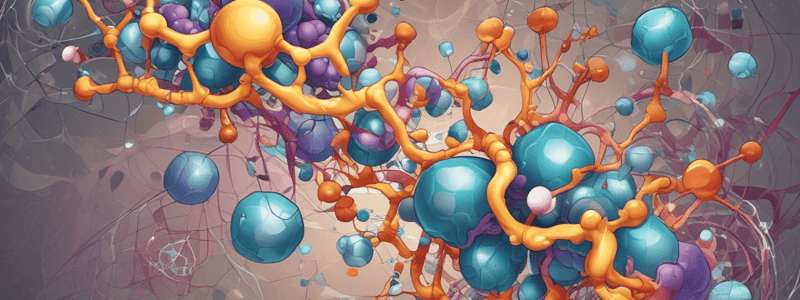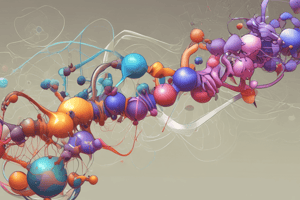Podcast
Questions and Answers
What is the effect of increasing substrate concentration on the velocity of the reaction?
What is the effect of increasing substrate concentration on the velocity of the reaction?
- It remains constant
- It decreases
- It increases initially, then becomes hyperbolic in shape (correct)
- It becomes zero order kinetics
What is the significance of Km value in enzyme kinetics?
What is the significance of Km value in enzyme kinetics?
- It is the substrate concentration at which 50% of enzyme molecules are bound with substrate molecules (correct)
- It is the substrate concentration at which the reaction rate is highest
- It is the maximum velocity of the reaction
- It is the enzyme concentration at which the reaction rate is lowest
What happens to the Vmax when the enzyme concentration is doubled?
What happens to the Vmax when the enzyme concentration is doubled?
- It becomes zero order kinetics
- It remains the same
- It decreases to half
- It increases to double (correct)
What is the relationship between the rate of a reaction and the enzyme concentration?
What is the relationship between the rate of a reaction and the enzyme concentration?
What is the shape of the reaction curve at relatively low concentrations of substrate?
What is the shape of the reaction curve at relatively low concentrations of substrate?
What is the effect of increasing substrate concentration on the kinetics of the reaction at first?
What is the effect of increasing substrate concentration on the kinetics of the reaction at first?
What is the significance of Km value in terms of enzyme concentration?
What is the significance of Km value in terms of enzyme concentration?
What is the term used to describe the plateau that appears at high substrate concentrations?
What is the term used to describe the plateau that appears at high substrate concentrations?
What is the effect of increasing the concentration of enzyme on the velocity of reaction, assuming unlimited substrate concentration?
What is the effect of increasing the concentration of enzyme on the velocity of reaction, assuming unlimited substrate concentration?
What is the temperature at which the maximum amount of substrate is converted to the product per unit time?
What is the temperature at which the maximum amount of substrate is converted to the product per unit time?
What happens to the activity of an enzyme when the temperature is increased beyond 50°C?
What happens to the activity of an enzyme when the temperature is increased beyond 50°C?
Why does the velocity of enzyme reaction decrease on both sides of the optimum pH?
Why does the velocity of enzyme reaction decrease on both sides of the optimum pH?
What is the typical pH range for optimum enzyme activity in humans?
What is the typical pH range for optimum enzyme activity in humans?
What happens to the reaction rate in a reversible reaction when the product concentration is increased?
What happens to the reaction rate in a reversible reaction when the product concentration is increased?
What is the effect of increasing the concentration of products on the velocity of enzyme reaction?
What is the effect of increasing the concentration of products on the velocity of enzyme reaction?
What is the consequence of an enzyme being blocked in a metabolic pathway?
What is the consequence of an enzyme being blocked in a metabolic pathway?
What is the result of competitive inhibition on the Km of an enzyme?
What is the result of competitive inhibition on the Km of an enzyme?
What type of inhibition is usually reversible?
What type of inhibition is usually reversible?
What is the effect of a non-competitive inhibitor on the Vmax of an enzyme?
What is the effect of a non-competitive inhibitor on the Vmax of an enzyme?
What is the purpose of sulfonamides as antibacterial agents?
What is the purpose of sulfonamides as antibacterial agents?
What is the binding site for a non-competitive inhibitor on an enzyme?
What is the binding site for a non-competitive inhibitor on an enzyme?
What is the result of increasing the substrate concentration in the presence of a competitive inhibitor?
What is the result of increasing the substrate concentration in the presence of a competitive inhibitor?
What is the effect of a competitive inhibitor on the enzyme-substrate complex formation?
What is the effect of a competitive inhibitor on the enzyme-substrate complex formation?
What is the purpose of calcium ions in enzyme activation?
What is the purpose of calcium ions in enzyme activation?
Flashcards are hidden until you start studying
Study Notes
Factors Affecting Enzyme Activity
- Substrate concentration:
- Velocity of reaction increases with increasing substrate concentration, initially in a linear relationship, then becoming hyperbolic
- Km (Michaelis constant) is the substrate concentration at half-maximal velocity, representing 50% of enzyme molecules bound to substrate
- Km is independent of enzyme concentration and remains constant for an enzyme
- Enzyme concentration:
- Velocity of reaction increases proportionally with enzyme concentration when sufficient substrate is present
- Temperature:
- Velocity of reaction increases with temperature, reaching a maximum (optimum temperature) and then decreasing
- Most human enzymes have an optimum temperature around 37°C
- pH:
- Each enzyme has an optimum pH, with velocity drastically reduced on either side of the optimum
- pH affects the charge on amino acid residues at the active site, influencing substrate binding and catalytic activity
- Concentration of products:
- In reversible reactions, increased product concentration slows down the reaction rate
- Enzyme activation:
- Certain inorganic ions (e.g., chloride and calcium) can activate enzymes
Enzyme Inhibition
- Competitive inhibition:
- Inhibitor molecules compete with substrate molecules for the active site, reducing available enzyme molecules
- Reversible, with excess substrate abolishing the inhibition
- Increases Km for the substrate, but does not affect Vmax
- Non-competitive inhibition:
- Inhibitor binds to a different domain on the enzyme, reducing enzyme activity
- Irreversible, with no competition between substrate and inhibitor
- Does not affect Km, but decreases Vmax
Pharmacological Applications
- Competitive inhibitors can be used as pharmacological agents, such as sulfonamides, which inhibit folic acid synthesis in bacteria by competing with PABA
Studying That Suits You
Use AI to generate personalized quizzes and flashcards to suit your learning preferences.



